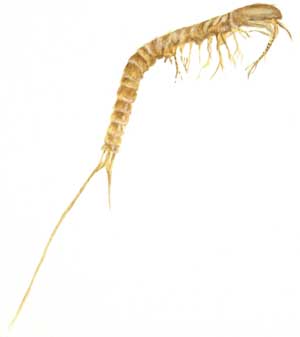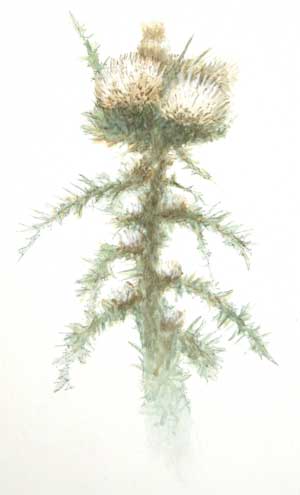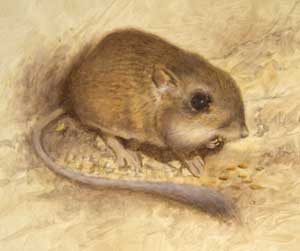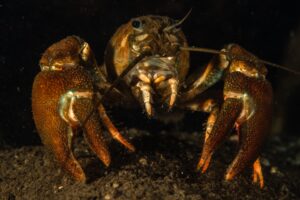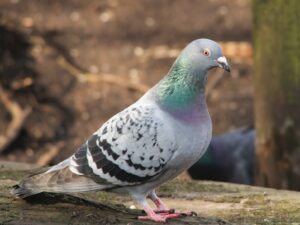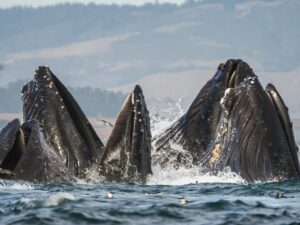If you look up any of the lost species featured in the pages of our October-December 2007 feature Presumed Extinct, you’re likely to find just that—the words presumed extinct followed by a brief natural history account, if you’re lucky. In the hope that these lost species might someday become Lazarus species—plants and wildlife that rise up from the dead—we’ve put together a field guide to help Bay Area naturalists in their search for the next Holy Grail.
While the likelihood of finding a lotis blue butterfly or Pitkin Marsh Indian paintbrush in your backyard or on a weekend hike are slim-to-none (both are restricted to private property), there’s no reason why a mail carrier might not stumble across a Palo Alto lost thistle on her way to the post office, or an itinerant hiker might not hit upon a Strohbeen’s Parnassian butterfly in the Santa Cruz Mountains. Or, realistically, why it’s worthwhile to reach for your field guide the next time your housecat leaves a present on the doorstep—it could be a Berkeley kangaroo rat! And then there’s Rich Mooi’s offer to those interested in visiting the California Academy of Sciences to learn about the Bay’s benthic creatures, a free ticket to paw through jars of mud in search of the San Francisco horseshoe shrimp. So read up; we’re counting on you to keep your eyes peeled!
SPECIES: Strohbeen’s Parnassian butterfly (Parnassius clodius strohbeeni)
LISTING STATUS: none
FIRST/LAST RECORDED: 1923/~1956
RANGE: known only from the Santa Cruz Mountains in Santa Cruz County
HABITAT: host plant is western bleeding heart (Dicentra formosa); redwood forests, well-lit canyon bottoms, stream zones
FIELD NOTES: of the Parnassian butterflies (P. clodius), Strohbeen’s Parnassian is a lighter sub-species restricted to the Santa Cruz Mountains; its closest cousins are found in the high inner North Coast Range, the Klamath Mountains, and the west slope of the Sierra Nevada; the Strohbeen’s Parnassian’s flight period is late May to early July
RESOURCES:
Field Guide to Butterflies of the San Francisco Bay and Sacramento Valley Regions, by Arthur M. Shapiro and Timothy D. Manolis
- Lotis blue butterfly (Lycaeides idas lotis). Illustration by DevinCecil-Wishing.”
SPECIES: lotis blue butterfly (Lycaeides idas lotis)
LISTING STATUS: federally endangered
FIRST/LAST RECORDED: 1879/1983
RANGE: scattered locations throughout Mendocino and Sonoma County; last known from a single location on PG&E land in Mendocino County’s Pygmy Forest
HABITAT: suspected host plant is seaside bird’s-foot trefoil (Lotus formosissimus); wet meadows, spagnum-willow bogs
FIELD NOTES: the lotis blue is often described as a larger version of its fellow blue, the Melissa blue butterfly (Lycaeides melissa); the lotis blue’s flight period is mid-April to June
RESOURCES:
Field Guide to Butterflies of the San Francisco Bay and Sacramento Valley Regions, by Arthur M. Shapiro and Timothy D. Manolis
Lotis Blue Draft Recovery Plan, March 13, 1996, by the U.S. Fish and Wildlife Service

- Clear Lake splittail (Pogonichthys ciscoides) illustration byDevin Cecil-Wishing.
SPECIES: Clear Lake splittail (Pogonichthys ciscoides)
LISTING STATUS: none
FIRST/LAST RECORDED: ~1930/~1970
RANGE: known only from Clear Lake in Lake County
HABITAT: Clear Lake and its tributary waters, plus an outlying record from Cache Creek (downstream of Clear Lake)
FIELD NOTES: a lake-bound cousin of the Sacramento splittail (P. macrolepidotus), Clear Lake’s shoreline splittail wasn’t officially described until 1973, approximately the time it went extinct; aside from geographic isolation, the differences between the species are morphological; compared to the Sacramento splittail, the Clear Lake splittail has more gill rakers, more lateral line scales, smaller fins, a terminal mouth with absent or reduced barbels, and a relatively symmetrical tail fin
RESOURCES:
Inland Fishes of California, by Peter B. Moyle
Field Guide to Freshwater Fishes of California, March 13, 1996, by Samuel M. McGinnis
SPECIES: thicktail chub (Gila crassicauda)
LISTING STATUS: none
FIRST/LAST RECORDED: present in Native American middens/1957
RANGE: reported specifically in Sacramento River, Putah Creek, Pajaro-Salinas drainage, Clear Lake, San Francisco Bay, Coyote Creek, Central Valley lowlands, and Bay tributary streams
HABITAT: lowland lakes, sloughs, slow-moving river stretches, and surface waters of the San Francisco Bay
FIELD NOTES: thicktail chub remains are reportedly common in Native American middens along the Sacramento River, and have been recovered from 19th-century Chinese privies in San Francisco’s Mission District; in the 19th century the fish was commonly sold in San Francisco fish markets and was served in Sacramento saloons; compared to other chub, the thicktail chub is a heavy-bodied fish with a small, cone-shaped head, greenish brown to purplish black back, and yellowish sides and belly
RESOURCES:
Inland Fishes of California, by Peter B. Moyle
Field Guide to Freshwater Fishes of California, March 13, 1996, by Samuel M. McGinnis
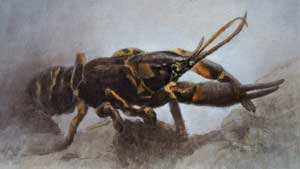
- Illustration based on Shasta crayfish photo by B. Moose Peterson/WRP
SPECIES: sooty crayfish (Pacifastacus nigrescens)
LISTING STATUS: none
FIRST/LAST RECORDED: 1857/late 1800S
RANGE: reported specifically in Alameda Creek, Coyote Creek, Steamboat Slough, and other Bay tributary streams
HABITAT: freshwater Bay tributary streams
FIELD NOTES: the sooty crayfish hasn’t been seen in over 100 years; the sooty crayfish closely resembles its cousin the Shasta crayfish (Pacifastacus fortis) but is blackish, smaller in size (4 inches long), and has more slender, hairless hands (claws)
RESOURCES:
Crayfishes (Astacidae) of North and Middle America, by Horton H. Hobbs
Ask the Naturalist—All the Crawdads You Can Eat (Bay Nature), March 13, 1996, by Michael Ellis
SPECIES: San Francisco horseshoe shrimp (Lightiella serendipita)
LISTING STATUS: none
FIRST/LAST RECORDED: 1961/1988
RANGE: known only from San Francisco Bay at Point Richmond, Brooks Island, Coyote Point
HABITAT: muddy sand bottom
FIELD NOTES: although extensive sampling has been done to rediscover this shrimp at its type locality and other collection locations, “searching” for this species amounts to sorting through Bay mud; mud-raker Richard Mooi of the California Academy of Sciences has generously offered would-be shrimp seekers the opportunity to pick through jars of mud—with the proper training, of course—to make sure no horseshoe shrimp have been overlooked— Reach Mooi at (415)321-8270.
RESOURCES:
Animals of San Francisco Bay: A Field Guide to Its Common Benthic Species, by Rich Mooi, Victor G. Smith, Margaret Gould Burke, Terrence M. Gosliner, Christina N. Piotrowski, and Rebecca K. Ritger
SPECIES: Palo Alto lost thistle (Cirsium praeteriens)
LISTING STATUS: CNPS List 1A (presumed extinct in California)
FIRST/LAST RECORDED: 1897/1901
RANGE: known only from Palo Alto in Santa Clara County
HABITAT: unknown
FIELD NOTES: with nothing but “Palo Alto” recorded for the type specimen’s collection location, botanists know nothing about this thistle’s preferred habitat; notes to the effect that the species represents an introduction from the Old World are unsubstantiated and the species is still recognized today as a native California thistle
RESOURCES:
CNPS Inventory of Rare and Endangered Plants of California, Online Edition, 2007, by the Rare Plant Scientific Advisory Committee, California Native Plant Society
Digitized type specimen at Harvard University Herbarium Index of Botanical Species
Flora of North America, Flora of North America Committee
SPECIES: Pitkin Marsh Indian paintbrush (Castilleja uliginosa)
LISTING STATUS: state Endangered; CNPS List 1A (presumed extinct in California)
FIRST/LAST RECORDED: 1937/1986
RANGE: Pitkin Marsh, Trembley’s Marsh in Sonoma County
HABITAT: marshy meadows
FIELD NOTES: the Pitkin Marsh Indian paintbrush grows solely in association with rhododendron plants in a type of hemiparasitic relationship; all known plants were reported on private land, which has prevented further surveys to determine if any unrecorded plants have persisted
RESOURCES:
Indian Paintbrush: The Sunset Shades of Castilleja (Bay Nature), by Geoffrey Coffey
CNPS Inventory of Rare and Endangered Plants of California, Online Edition, 2007, by the Rare Plant Scientific Advisory Committee, California Native Plant Society
SPECIES: Berkeley kangaroo rat (Dipodomys heermanni berkeleyensis)
LISTING STATUS: Species of special concern
FIRST/LAST RECORDED: 1918/1940
RANGE: Berkeley (Strawberry Canyon), Mt. Diablo, and the East Bay Hills (Orinda Park Pool, Siesta Valley, Calaveras Reservoir)
HABITAT: bare ridge tops, rocky outcrops, thin soils, scattered chaparral, and small annual grasses
FIELD NOTES: the Berkeley kangaroo rat closely resembles the Tulare kangaroo rat (D. h. tularensis), but can be distinguished by generally darker hairs, especially along the back, as well as darker broad stripes along the sides and tail, and smaller patches of lighter hairs on the ears and face; look for k-rat hunter Gary Beeman’s “Wanted!” posters in kiosks surrounding Mount Diablo State Park; if you want to tip off Beeman about a potential k-rat in your neighborhood, you can reach him at (925)284-2602
RESOURCES:
Draft Recovery Plan for Chaparral and Scrub Community Species East of San Francisco Bay, California, by the U.S. Fish and Wildlife Service
GENERAL RESOURCES
CALIFORNIA RARE PLANTS AND ANIMALS LISTS
The California Department of Fish and Game maintains regularly updated lists of the state’s special-status plant and animal species, from high-profile threatened and endangered species to “species of special concern,” whose populations are dwindling and may warrant state or federal listing action in the future.
Special Vascular Plants, Bryophytes, and Lichens List (.pdf)
Special Animals List (.pdf)
Endangered, Threatened, and Rare Plants List (.pdf)
Endangered and Threatened Animals List (.pdf)
Fully Protected Animals List(.pdf)
Fish Species of Special Concern List (.pdf)
Amphibian Species of Special Concern List (.pdf)
Reptile Species of Special Concern List (.pdf)
Bird Species of Special Concern List (.pdf)
Mammal Species of Special Concern List (.pdf)
BOTANICAL RESOURCES
Jepson Online Interchange for California Floristics, Jepson Flora Project
CNPS Inventory of Rare and Endangered Plants of California, Online Edition
CONSERVATION ORGANIZATIONS AND LAND TRUSTS
The U.S. Fish and Wildlife Service and the California Department of Fish and Game aren’t the only agencies working to protect and conserve species and their habitat. There are many organizations and institutions that devote time, money, and resources to research and conservation efforts on behalf of plants and wildlife in the Bay Area, not to mention world-wide. Those whose goals and sphere of influence overlap with the Bay Area’s lost species are listed below:
CONSERVATION ORGANIZATION
Butterfly Organizations
Entomological Society of America
North American Butterfly Association
The Pacific Coast Entomological Society
North American Pollinator Protection Campaign
Plant Organizations
California Native Plant society
Crustacean Organizations
Wildlife Organizations
Land Trusts
UC Natural Reserves [Jepson Prairie Preserve]
Museums
California Academy of Sciences, San Francisco
Museum of Vertebrate Zoology, Berkeley
Museum of Comparative Zoology, Harvard University
American Museum of Natural History, New York
Essig Museum of Entomology, Berkeley
Herbaria & Botanical Gardens
University of California Botanical Garden at Berkeley
San Francisco Botanical Garden at Strybing Arboretum
The University and Jepson Herbaria
Herbarium of the California Academy of Sciences
THE BAY AREA’S HOLY GRAIL—MOUNT DIABLO BUCKWHEAT
The inspiration behind “Presumed Extinct: Lost Species of the Bay Area” was the rediscovery of the Bay Area”s own ivory-billed woodpecker, the Mount Diablo buckwheat. You can learn more about Mount Diablo and its phantom buckwheat through the following features and press releases:
Bay Nature Magazine
Speak of the Devil: The Unexpected Landscapes of Mount Diablo
The Mount Diablo Buckwheat One Year Later
Save Mount Diablo
Press Release: “Mt. Diablo Buckwheat Rediscovered”
California State Parks
REDISCOVERED “LAZARUS SPECIES” AROUND THE WORLD, AND MORE
When so-called “extinct” species rise from the dead—as we hope our lost Bay Area species are fated to do—they become what are appropriately referred to as “Lazarus species.” You can learn more about such species and how they become extinct, as well as test your knowledge on global extinction—through the links below:
“How are species classed as extinct?”
Attenborough’s Long-Beaked Echidna—”New hope over ‘extinct’ echidna”
White Dolphin “baiji”—White Dolphin Appears from the Brink
Manipur Bush-Quail—”‘Extinct’ quail sighted in India”
Giant Capricorn Beetle—”Carpenter finds ‘extinct’ beetle”
Painted Frog—”‘Extinct’ frog comes back to life”
Tasmanian Tiger—”Hunting Tasmania’s extinct ‘tiger'”

.jpg)

